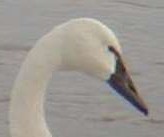 if it
had an all black bill it was a Tundra Swan (Cygnus columbianus),
if it
had an all black bill it was a Tundra Swan (Cygnus columbianus), Swan Identification in upstate New York.
All pictures were taken by Jay and Kevin McGowan with an Olympus D-450 digital camera through a Swarovski HD-80 spotting scope.
All photos © Kevin J. McGowan
It used to be that telling species of swans apart in upstate New York was a simple matter:
 if it
had an all black bill it was a Tundra Swan (Cygnus columbianus),
if it
had an all black bill it was a Tundra Swan (Cygnus columbianus),
but if the base of the bill was orange, it was the introduced Mute Swan (Cygnus
olor). 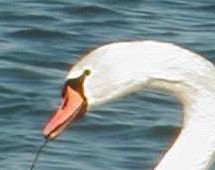
With the reintroduction programs of Trumpeter Swans (Cygnus buccinator) in a number of states and provinces, as well as the unofficial private "reintroduction program" of at least one waterfowl breeder in the area (see D. Carroll and B. L. Swift. 2000. Status of the Trumpeter Swan in New York State. Kingbird 50(3): 232-236), we now are faced with a tougher ID problem: telling Tundra from Trumpeter. Both have black bills, and therefore are harder to distinguish.
On 23 April 1993, I discovered a free-flying, unbanded Trumpeter Swan in the Savannah Mucklands along Route 31 near the Seneca River, Town of Tyre, Clyde Co. It was alone in a flooded field, and had its head underwater foraging. I stopped and waited for it to show its bill color, and nearly sped away after I saw that it was black. Something, however, didn't look right, and I stopped the car and took closer note of its appearance. I confirmed to my satisfaction that it was a Trumpeter Swan, a species not on the New York state list. The bird was officially ruled "Identity accepted, origin unknown" by NYSARC. Since that time I have been interested in identifying stray swans in the area.
The first known breeding pair of Trumpeter Swans in New York was found at Perch River Wildlife Management Area in Jefferson Co. in 1996, and several other pairs have been found. The species still is not on the official New York state list, but it probably will be in the future as the species becomes established here or in neighboring areas. It is beneficial for all birders to pay attention to the species and to report sightings so that we can keep track of the species' population numbers and movements in the state.
How to tell them apart?
Trumpeter Swans are larger than Tundras, but that is of little help. All swans are huge birds, and any difference in size would only be apparent if the two species were right next to each other. And even then a fluffed Tundra probably could look bigger than a sleeked Trumpeter.
I have found the face to be the best place to look to distinquish the two species. Tundras usually have some yellow on the lores, while Trumpeters never do. The yellow on Tundras, however, is extremely variable, and may be completely absent. It would be well worthwhile to peruse a flock of Tundras and get a feeling for the amount of variation exhibited. Trumpeter Swans show pink or deep orange at the edge of the bill, while Tundras show no color or only a little. Trumpeters have a longer, flatter bill, and a more flattened profile and head shape (somewhat Canvasback-like). Tundras have more rounded heads and slightly concave bills.
To me, the best character is the placement of the eye within the black mask. The eye of a Trumpeter looks contained within the black mask of the face, while the eye of a Tundra looks nearly separate, connected only by a small area directly in front of the eye. (This connection can look even narrower because of the yellow lores.) At a quick glance, you can see the position and size of a Tundra Swan's eye easily, while that of a Trumpeter is more hidden.
Here are some photos of the two species that Jay and I have taken to illustrate the points. All the Tundra Swan photos were taken at the Savannah Mucklands along state route 31 in February 1999 (some of the very first photos we took with the digital camera through the spotting scope!). The Trumpeter pictures were taken 14 October 2001 of a pair at a small pond on Hogsback Road in Wayne Co., NY. The status of this pair, whether captive or feral, is unknown to me.
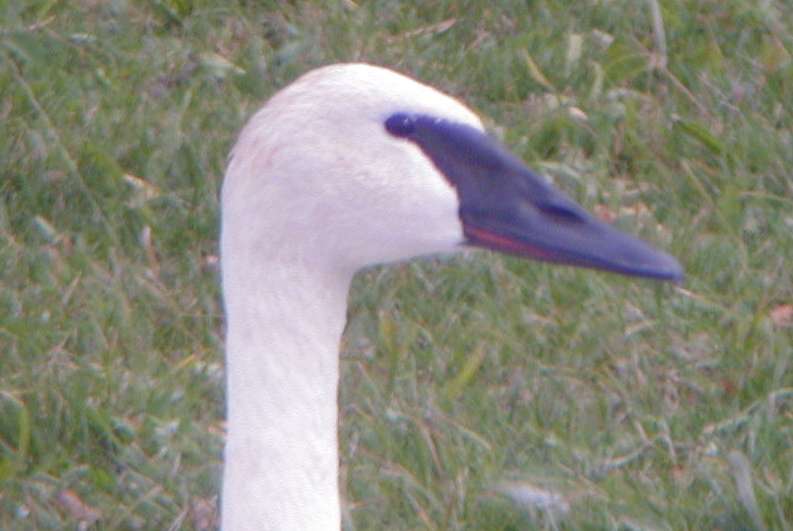 This closeup of the
head of Trumpeter Swan shows the orange at the bill edge, lack of yellow lores, broad
black connection of the eye and the mask, and the flattened crown and straight bill.
This closeup of the
head of Trumpeter Swan shows the orange at the bill edge, lack of yellow lores, broad
black connection of the eye and the mask, and the flattened crown and straight bill.
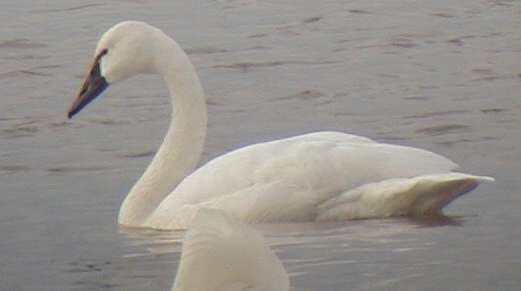 This
Tundra Swan shows only a small yellow spot on the lores, but notice how distinct the eye
is from the black mask and how rounded the head is.
This
Tundra Swan shows only a small yellow spot on the lores, but notice how distinct the eye
is from the black mask and how rounded the head is.
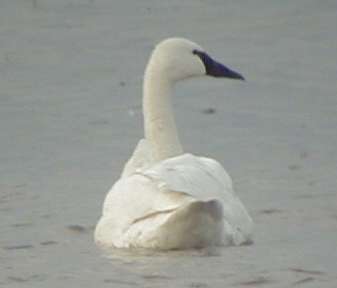 This Tundra Swan
has a rather flat profile and bill, as well as a barely discernable yellow spot, but the
eye is clearly distinct.
This Tundra Swan
has a rather flat profile and bill, as well as a barely discernable yellow spot, but the
eye is clearly distinct.
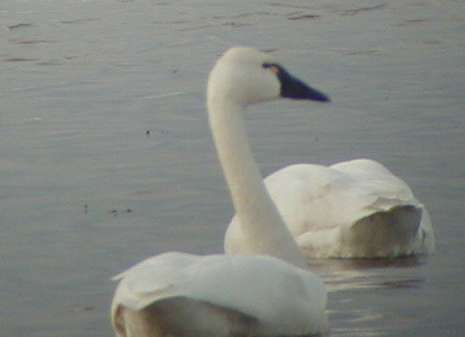 This
Tundra Swan has a more noticeable yellow spot that makes the eye look barely connected to
the mask.
This
Tundra Swan has a more noticeable yellow spot that makes the eye look barely connected to
the mask.
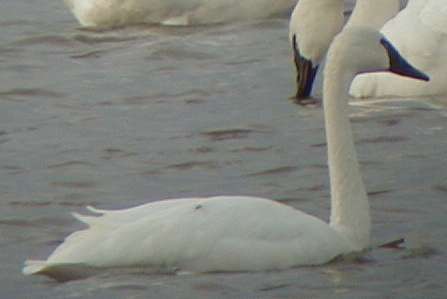 The eye is less
distinct on this Tundra Swan, but the rounded head and concave bill call it a Tundra, an
identification confirmed by the yellow spot.
The eye is less
distinct on this Tundra Swan, but the rounded head and concave bill call it a Tundra, an
identification confirmed by the yellow spot.
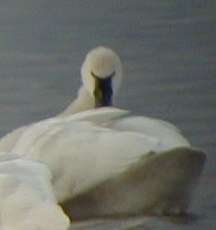 This is the only forehead shot I have, showing the shallow "U"-shaped forehead
of a Tundra Swan. A Trumpeter would have a more V-shaped look with a pointed front
border of white into the black, formed presumably by the the more swollen area above the
nostrils.
This is the only forehead shot I have, showing the shallow "U"-shaped forehead
of a Tundra Swan. A Trumpeter would have a more V-shaped look with a pointed front
border of white into the black, formed presumably by the the more swollen area above the
nostrils.
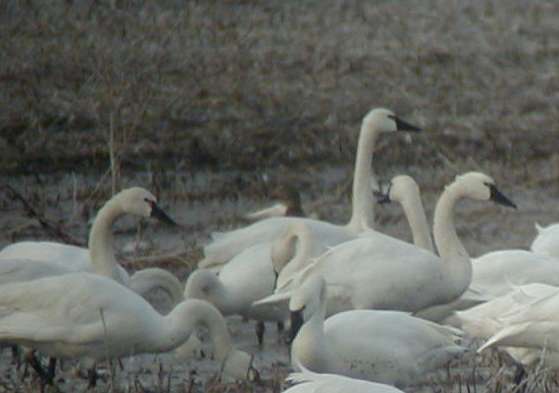 Note the
varying amount of yellow on theseTundra Swans and the differences in head shape, but all
have prominent eyes.
Note the
varying amount of yellow on theseTundra Swans and the differences in head shape, but all
have prominent eyes.
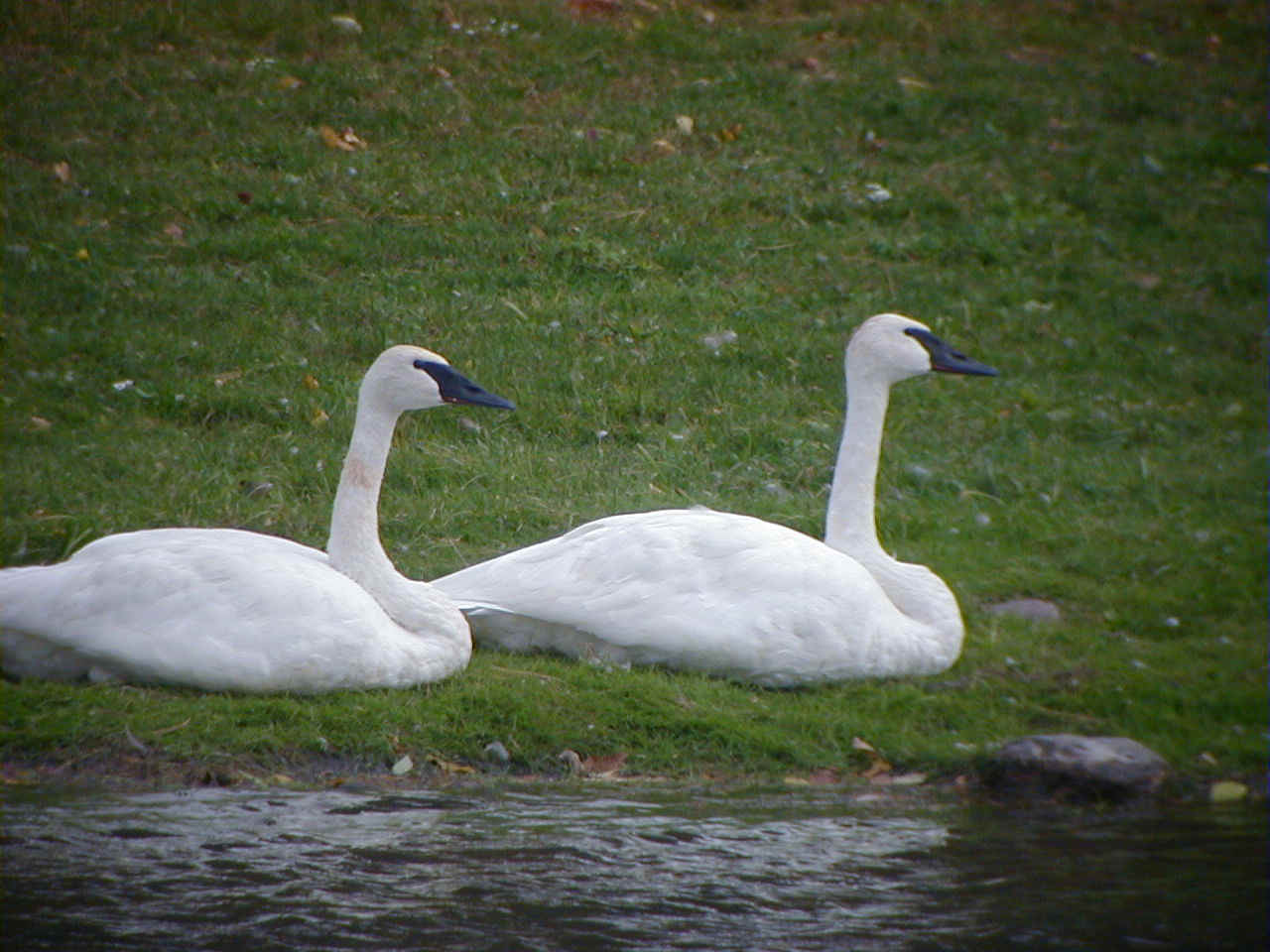 This pair of Trumpeter
Swans shows another character that is supposed to work to distinquish the species:
the S-shaped kink at the base of the neck where the neck seems to be at rest on the
back. Unfortuantely I don't have comparable pictures of Tundras.
This pair of Trumpeter
Swans shows another character that is supposed to work to distinquish the species:
the S-shaped kink at the base of the neck where the neck seems to be at rest on the
back. Unfortuantely I don't have comparable pictures of Tundras.
Another clue in our area is timing of observations. Tundra Swans are migratory and most pass through the state, with a small number wintering here. They are most numerous 12 March - 8 May, 19 October - 25 November (Beardslee and Mitchell. 1965. Birds of the Niagara Frontier Region. Bull. Buffalo Soc. Nat. Sci. 22). Swans seen outside of those dates should be suspected of being Trumpeters.
Return to the Bad Photos page.
Return to Kevin McGowan's home page.
Go to the Crow Page.